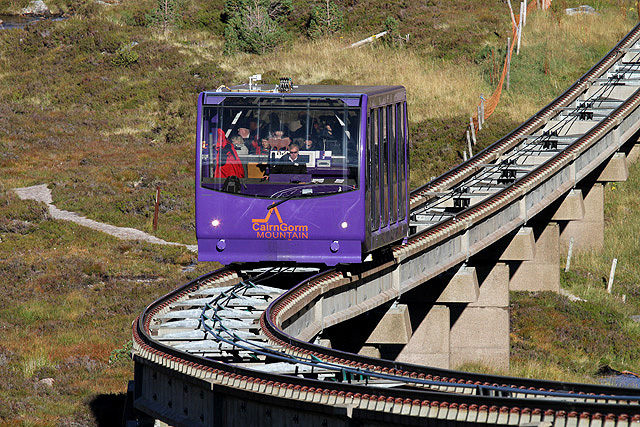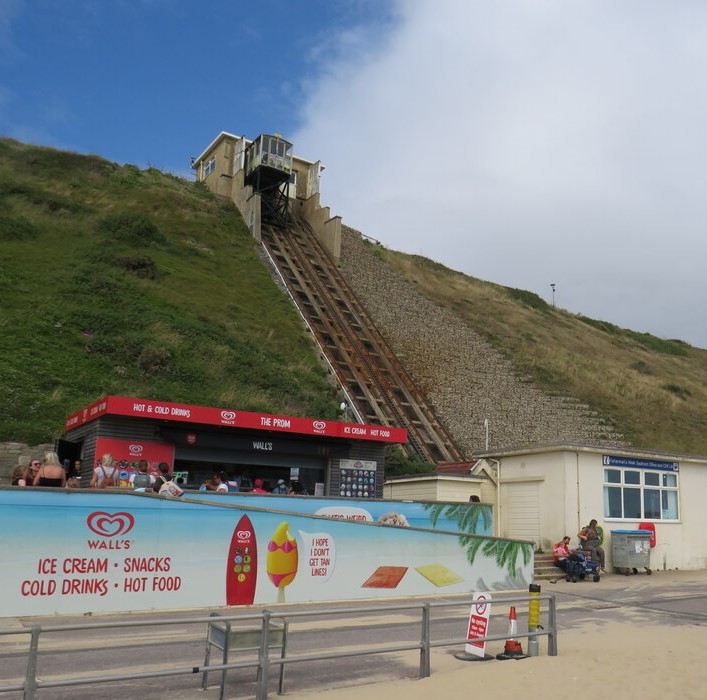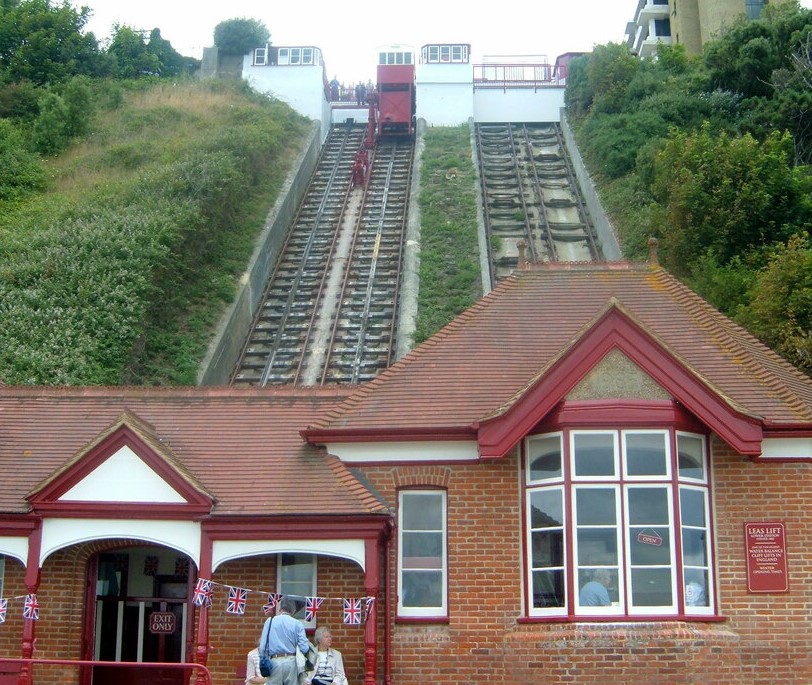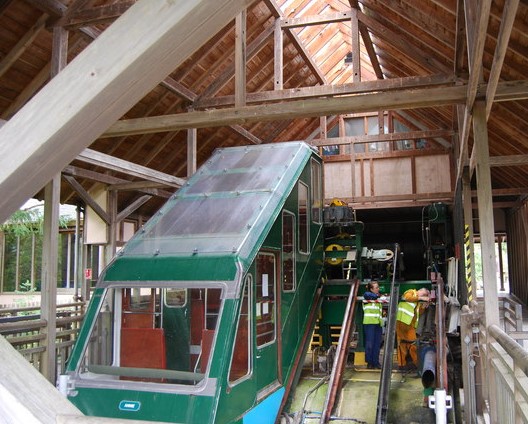Funicular
Contents |
[edit] Introduction
In the general sense, the term funicular relates to the use of a rope and its tension for different purposes. Funicular comes from the Latin word for rope or string, which is funiculus. The term is associated with several related concepts, including funicular railways and funicular forms.
[edit] Funicular railways
This type of cable railway system (sometimes simply referred to as a funicular) is a form of transport that is often used at ski slopes or mountainous regions. It combines the concepts of an elevator (where technology uses a cable to move a carriage) with a train (where a carriage is moved along a track) to transport people (or objects) up steep inclines.
A funicular is sometimes referred to as an inclined plane railway or a cliff railway. On the incline, there is typically a single track to support the movement of two carriages. As the carriages approach each other, the track diverges into two separate tracks (or passing loops).
The movement of funiculars is controlled by a system of counter balanced carriages attached to each other with a cable. The haulage cable (or haul rope) is looped through a system of pulleys that reaches to the apex of the incline.
While the initial energy comes from a motor, neither carriage is equipped with an engine or motor (since the carriages counterbalance each other). This means one carriage moves downward safely as the speed of its descent is controlled by the weight of the other carriage moving upward. There is no great demand for new energy and lifting force to perpetuate the motion of the carriages.
Wheels under the carriages served to guide them on the tracks - they do not provide pulling power as they would with other types of railways. If the tracks are not entirely straight, the cable uses unpowered pulleys known as sheaves to guide it in the proper direction (or change direction completely) and the wheels follow the same path.
Funiculars differ from inclined elevators - despite their similar appearance and purpose - because the carriages of inclined elevators operate independently while the movement of one funicular carriage depends on the movement of the other.
There is evidence of early funiculars dating to the 15th century. Some of these early devices used power generated by humans or animals to move the carriages.
Water was another method of operation. These devices moved as the level of water in reserve tanks filled and emptied. There are a few water powered funiculars still in operation.
While many funiculars are open, some have been built into overground tunnels. Others have been built for the purpose of providing descent into caves or mines below ground or to transport passengers for underground travel.
[edit] Funiculars in the UK
Funiculars have been used throughout the UK, with a number deployed in coastal areas. On the Isle of Man, funicular railways were used to support tourism in the mid-19th century, but none of these funiculars are still in operation.
Some noteworthy funiculars in the UK include:
Aviemore, Cairngorm Mountain Railway. The Cairngorm funicular was once the highest railway in the United Kingdom. It opened in 2001 but closed in 2018 due to structural issues.
|
Cairngorm Mountain Railway. This view of an ascending railway car was taken from a track by the middle station in Coire Cas. |
Bristol, Clifton Rocks Railway. Built within a tunnel, this underground funicular was also water powered. It is situated near the Clifton Suspension Bridge but closed in 1934 due to lack of use.
|
This is the Clifton Rocks Railway, lower station, as seen from across the River Avon. The concrete buttressing was added in the late 1950s when the tunnel was being used by the BBC as a transmitting station. At that time it was found that geological faulting was causing the façade to separate from the rock face. |
Bournemouth, Fisherman's Walk Cliff Railway. At 39 metres (128 feet), this is believed to be the smallest public funicular in the world.
|
Fisherman's Walk Cliff Railway. |
Kent, Leas Lift. This grade II listed, water-operated funicular was installed in 1885 and is in operation (as of 2021).
|
Leas Lift. The Folkestone Cliff Lift aka Leas Lift aka Leas Cliff Railway is a water balanced funicular that first opened in 1885. The water recycling started in 1890. |
Lynton and Lynmouth, Lynton and Lynmouth Cliff Railway. Climbing 152 metres (499 feet), this is the steepest and longest water-powered funicular in the world.
Lynton and Lynmouth Cliff Railway. 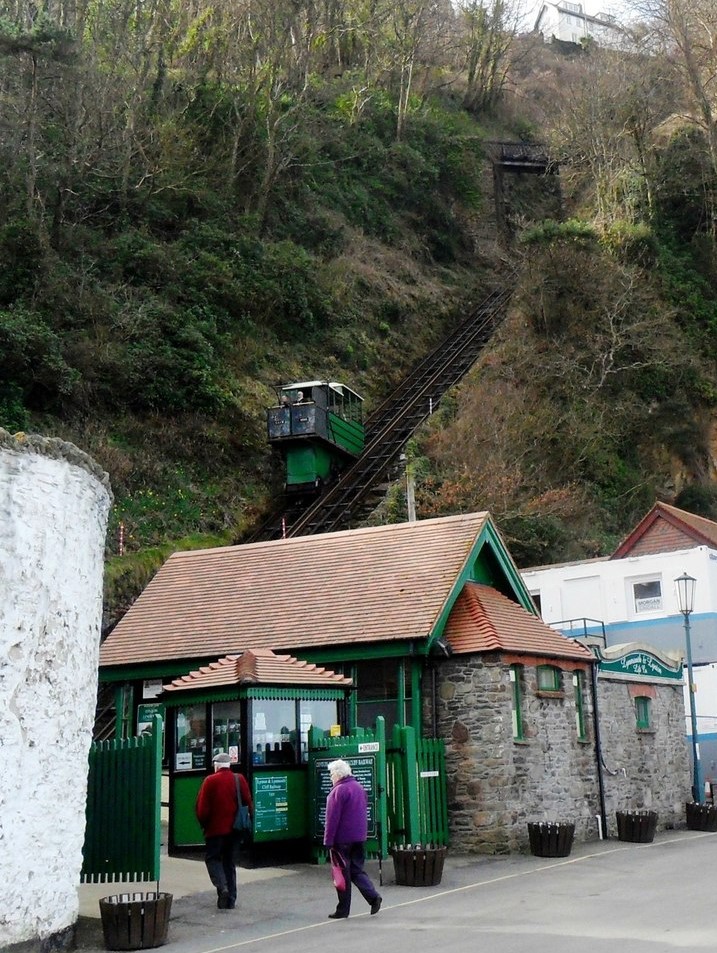
|
Machynlleth, CAT funicular. This water-balanced funicular opened in 1992 at the Centre for Alternative Technology (CAT), which is an organisation associated with sustainable living and development.
|
CAT Funicular. |
[edit] Funicular forms
Funicular forms are the forms assumed by cables (or chains) under any given load.
Although funicular forms and catenary forms look very similar, they are mathematically different. In mathematical representation, the catenary uses a hyperbolic cosine while the parabola is far easier to represent with just a polynomial. Engineers may sometimes use the mathematics for a parabola when considering a catenary.
|
A chain hanging freely, with no applied load and supported freely at both ends (which are not in a vertical line) takes the form of a catenary. |
Both forms are always in tension and may be described as funicular forms, which are the forms assumed by cables (or chains) under any given load. The catenary is funicular because it bears only its own load, while the parabola is funicular because it carries load, as in a suspension bridge.
[edit] Related articles on Designing Buildings
Featured articles and news
Delivering for tenants; National Retrofit Hub
New report offers recommendations to strengthen energy efficiency standards to protect private renters.
Government consultations for the summer of 2025
A year of Labour, past and present consultations on the environment, the built environment, training and tax.
CMA competitiveness probe of major housing developers
100 million affordable housing contributions committed with further consultation published.
Homes England supports Greencore Homes
42 new build affordable sustainable homes in Oxfordshire.
Zero carbon social housing: unlocking brownfield potential
Seven ZEDpod strategies for brownfield housing success.
CIOB report; a blueprint for SDGs and the built environment
Pairing the Sustainable Development Goals with projects.
Types, tests, standards and fires relating to external cladding
Brief descriptions with an extensive list of fires for review.
Latest Build UK Building Safety Regime explainer published
Key elements in one short, now updated document.
UKGBC launch the UK Climate Resilience Roadmap
First guidance of its kind on direct climate impacts for the built environment and how it can adapt.
CLC Health, Safety and Wellbeing Strategy 2025
Launched by the Minister for Industry to look at fatalities on site, improving mental health and other issues.
One of the most impressive Victorian architects. Book review.
Common Assessment Standard now with building safety
New CAS update now includes mandatory building safety questions.
RTPI leader to become new CIOB Chief Executive Officer
Dr Victoria Hills MRTPI, FICE to take over after Caroline Gumble’s departure.
Social and affordable housing, a long term plan for delivery
The “Delivering a Decade of Renewal for Social and Affordable Housing” strategy sets out future path.
A change to adoptive architecture
Effects of global weather warming on architectural detailing, material choice and human interaction.
The proposed publicly owned and backed subsidiary of Homes England, to facilitate new homes.
How big is the problem and what can we do to mitigate the effects?
Overheating guidance and tools for building designers
A number of cool guides to help with the heat.
The UK's Modern Industrial Strategy: A 10 year plan
Previous consultation criticism, current key elements and general support with some persisting reservations.
Building Safety Regulator reforms
New roles, new staff and a new fast track service pave the way for a single construction regulator.








